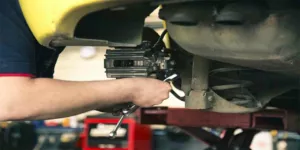Driving a vehicle is probably one of the riskiest things people engage in, but if you learn to check your car properly before starting, you can prevent many complications and mishaps.
Regardless of whether it is a drive to work and back or a lengthy ride, make sure that before starting your car, you check the following very important things.
1. Fuel
Confirm that you’ve got plenty of fuel in your tank for the ride. It sounds obvious but you will be shocked how many people run out of gasoline in the middle of their journey, particularly in harsh winter weather conditions.
2. Brake, Clutch, and Transmission Fluid
As a precautionary measure, check the amount of brake, clutch and transmission fluid in your car to ensure that the volume available matches the required level limit. Note that if you discover oil spill stains on the floor where the vehicle was parked, it means that you have fluid leakage somewhere, and getting this sorted out should be top of your priorities.
You should check for oil quantity and spills when the car is turned off for a brief period and it needs to be parked on a horizontal plane.
Though it’s extremely unlikely for the fluid levels to go low, there can be a leak in the system or if the vehicle has not been serviced on a regular basis.
3. Engine Oil
Before starting your car, look for oil spills or leakage beneath the engine. Then, take a dipstick test to check the engine oil level and top up if necessary.
4. Battery
You can manually check the battery’s state and see if there are any holes or acid leakage. The ends of the battery should be solid and not corroded. If your visual checks reveal any malfunction of if your battery appears swollen, then it should be replaced.
5. Tyres
Your tyres are the most critical factors when it comes to safety when driving. Over time, tyres wear down, especially when it is beginning to reach its end of life or as a result of constant usage. Before setting out for a road trip, you should inspect your tires to be sure that they are road safe. You can do a visual inspection by looking at both your tire tread and checking its pressure.
Damaged or improperly inflated tyres may blow-out or lose traction and cause an accident. Ensure the tires are installed properly and inflated to the appropriate size.
Use a tyre pressure gauge while the tyres are cold to ensure that the pressures suit those specified in the owner’s manual.
6. Coolant
Before starting your car, check the amount of coolant the car has. The last thing you need is a freezing battery, or to overheat your vehicle. Even if it’s a sealed device and shouldn’t need to be augmented, you should still double-check, particularly before a long journey.
Check the coolant rates while the engine is cold, and search for the right coolant and combination to use in your owner’s manual if you decide to top it.
7. Leaks
Leaks have little to do with a car’s age can happen due to a variety of causes. Leakages in new or old vehicles are similarly troubling and demand the same standard of treatment.
Many leaks are common, such as the clear water from an air conditioning device, whereas oil stains or colourful spills have more severe implications.
It’s recommended that you look under and around the vehicle and be sure you’re comfortable with the leaks you see depending on the colour and area of the leak.
8. The Lights
It’s risky to drive while even one of the lights on your vehicle is not working properly. Make sure to check brake lights, reverse lights, turn signals, and your headlights. You are not likely to notice a malfunctioning tail light or brake light, so be sure to always check them before starting your car.
Your brake and reverse lights are critical to letting other drivers realise what you’re doing or are going to do – and avoid accidents. Also, remember that you may get a ticket if any of your lights are not working.
9. The Warning Lights
When you see any warning lights in your car, please do not disregard it. Check to see what the problem is. The check engine light could warrant taking the car to a mechanic. The oil warning light may be letting you know you’re working on older oil so it’s time to change.
Make sure to top off with coolant before beginning your drive, if the car is heating up too often.
10. Wipers
You need to check your wipers before you embark on a road trip. In the event of a downpour, you don’t want to find yourself without wipers. The wipers ensure water is removed from the windscreen for you to see the road clearly while driving.
If water lines fall on your windscreen during a downpour, your visibility may be affected when driving with malfunctioning wipers.
A quick way to check the wipers is to pour water on the windscreen to see how the wipers will keep the water off.
11. Mirrors
A car’s mirrors are a fantastic protective device, but only if employed correctly. With a slight movement of your eyes, mirrors help you see the sides and behind, so if they’re not matched to your height and head location, they won’t do you much good.
Position your rear-view mirror to give you a good picture of the field behind your vehicle and your side mirrors to clearly cover the lane on either side of you.
12. The Gears
Check the gears to see that they all operate well. Are they jamming up or stuck? This may indicate that they need servicing. Before starting the engine, do not fail to put the gear back in neutral.
In Conclusion
Always endeavour to do some quick checks before starting your journey to make things more convenient and safe for you. You can enjoy a smooth trip to and fro by taking the time to check the aforementioned items and devices regardless of how short or long the ride is.
Keeping these pieces of advice in mind and routinely carrying them out will ensure your car remains in great shape.
Written by Alan Parker







